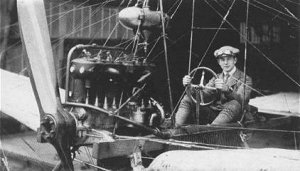 Dutchman
Anthony Fokker, who built famous aircraft later on, flew in 1911 above the old
Dutch town of Haarlem, in his "Spin" (which means Spider). He chose
this name because of all the wires on his aeroplane.
Dutchman
Anthony Fokker, who built famous aircraft later on, flew in 1911 above the old
Dutch town of Haarlem, in his "Spin" (which means Spider). He chose
this name because of all the wires on his aeroplane.After Wilbur and Orville (1903 - 1940)
Although nobody had really flown in 1903, other researchers were not idle in this field. The Frenchman Levavaseur had built a light engine, "Antoinette", rated at 24 HP. This was the engine to be used in a number of different aeroplanes.
In 1906 some French aircraft builders became well known:
Farman, Voisin, Blériot and Santos Dumont. These were names that would become
very familiar. Aircraft were getting better and better, though slowly. It was
not until January 1908 when Henri Farman flew longer and further than the
Wrights on December 17th, 1903. Later that year Wilbur surprised everyone in
France to stay airborne one hour and 31 minutes.
In 1909 Frenchman Louis Blériot crossed the English Channel to Great
Britain, a distance of 40 km.
 Dutchman
Anthony Fokker, who built famous aircraft later on, flew in 1911 above the old
Dutch town of Haarlem, in his "Spin" (which means Spider). He chose
this name because of all the wires on his aeroplane.
Dutchman
Anthony Fokker, who built famous aircraft later on, flew in 1911 above the old
Dutch town of Haarlem, in his "Spin" (which means Spider). He chose
this name because of all the wires on his aeroplane.
In 1912 the British factory AVRO built an aeroplane with a closed cabin. They were ahead of their time.
The German Junkers factory built an all metal aircraft. It was built of aluminium, a light and strong material. That is to say, for an aircraft. The aluminium you can buy in the building shop is much weaker.
The Great War (1914-1918) proved to be a time in
which aircraft improved dramatically. At first they were used for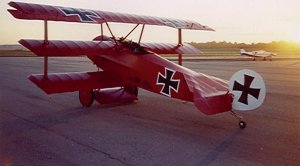 reconnaissance. You
can see the enemy better in the sky than from the ground. Soon pilots started to
shoot at each other when engaging another aeroplane. First with pistols, soon
with machine guns.
reconnaissance. You
can see the enemy better in the sky than from the ground. Soon pilots started to
shoot at each other when engaging another aeroplane. First with pistols, soon
with machine guns.
Very soon machine guns were attached to the front of the aeroplane. To prevent
shooting the propeller to pieces, metal plates were attached to it. Fokker
invented a way to synchronize the shooting with the propeller, enabling him to
avoid shooting against the propeller, but between the blades.
Another advantage of the aeroplane was the throwing of little bombs out of the
cockpit, just out of the hand on top of the enemy. The bomber was born!
During this war ten thousands of aeroplanes were
built.
At the end of the Great War the aeroplane had become mature. It was not an
innocent machine anymore. Military use had become a standard until today.
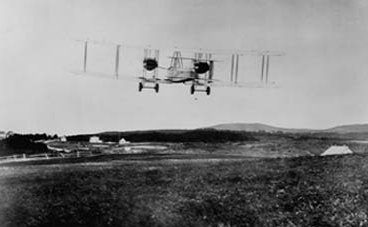 In
1919 the British John Alcock and Arthur Brown made the first flight acros the
Atlantic. They flew the two-engined Vickers "Vimy" bomber from New
Foundland (Canada) to Ireland because western winds prevail. The Vimy was a two
engined biplane. Alcock and Brown did win a significant reward, put up by a British
newspaper.
In
1919 the British John Alcock and Arthur Brown made the first flight acros the
Atlantic. They flew the two-engined Vickers "Vimy" bomber from New
Foundland (Canada) to Ireland because western winds prevail. The Vimy was a two
engined biplane. Alcock and Brown did win a significant reward, put up by a British
newspaper.
How advanced had the aeroplane become? In 1920 many records had been broken:
After the Great War may pilots were idle. There was no work anymore because the war had ended. There were many surplus aeroplanes and there was a lot of interest in aviation. The first airlines emerged. One of them was KLM (Royal Dutch Airlines), founded in 1919. At first flying only took place from Amsterdam to London, in fair weather with old military aeroplanes. Passengers had to put on a thick coat and they got a thermos flask with coffee.
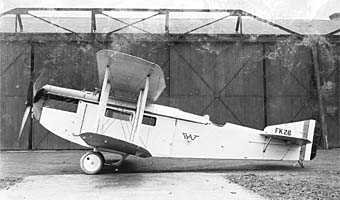 Dutchman
Frits Koolhoven designed the first airliner in the world, in 1919. He did so
while being in the service of the B.A.T. company in Britain.
Dutchman
Frits Koolhoven designed the first airliner in the world, in 1919. He did so
while being in the service of the B.A.T. company in Britain.
His B.A.T. FK 26 could carry four passengers in a closed cabin. The pilot however,
was stil in the open air. The FK 26 is shown at the left.
In the same year the German Junkers built an all metal aeroplane that could
carry five passengers.
In 1920 Fokker built his first airliner that could carry five passengers: The
Fokker F-2.
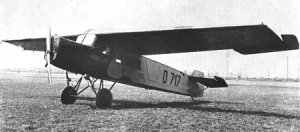 |
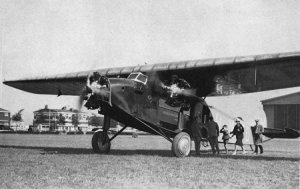 |
| Fokker F 2 | Three-engined Fokker F-7, (KLM) |
In 1927 the Fokker F-7 was launched. At first with one, but soon with three engines. Admiral Byrd flew one over the Antarctic. In those days KLM flew to the Dutch East Indies, at the other end of the world. December 18th 1933, KLM Fokker F-18 "Pelikaan" (Pelican) started for a record breaking flight to the Indies. It arrived on December 22nd at the airport of Batavia (now Jakarta).
Four days later the crew headed back for the Netherlands. December 30th they landed at Schiphol airport near Amterdam. In those days this was a major achievement. There was a huge crowd at Schiphol; all wanted to see the arrival.
In 1927 Charles Lindbergh made the first solo
flight
across the Atlantic in his one-engined "Spirit of Saint Louis". He was
airborne for more than 32 hours and at a moment he even fell asleep. Just in
time, very close to the surface, he awoke.
When aeroplanes got bigger the service personnel appeared on the stage. US
companies hired stewardesses for the first time in history.
Fokker kept on building aircraft, but the way he did this, became old-fashioned. Fokkers were built from a metal frame covered with fabric. The wings were still made out of wood. The KLM wanted something different. In 1934 they bought the Douglas DC-2, the all-metal American airliner. The first DC-2 was called "Uiver" (or Stork; KLM always used names of birds) and this machine became second in the famous Melbourne race. This was well done because all other competitors were flying specially built race aeroplanes. The following year the DC-3 appeared. It became renown as C-47 "Skytrain" or "Dakota" In World War II. Thousands were built and hundreds are still flying currently.
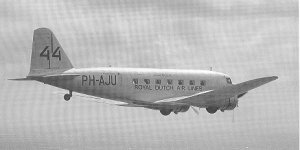 |
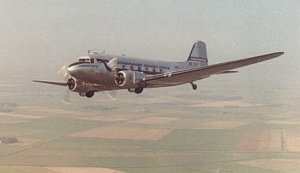 |
| De KLM DC-2 "Uiver" | DC-3 or
WWII C-47 "Skytrain". The British named her "Dakota". |